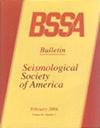墨西哥城板块间和中深度板块内地震的水平和垂直地动持续时间预测模型
IF 2.9
3区 地球科学
Q2 GEOCHEMISTRY & GEOPHYSICS
引用次数: 0
摘要
在本研究中,我们提出了墨西哥城板块间地震和中等深度板块内地震引起的重大地动持续时间的预测模型,包括水平分量、垂直分量以及垂直与水平比率情况。所考虑的地点位于墨西哥城的多个区域,从岩石地点到软土地点。对于地动持续时间模型,分析考虑了阿里亚斯强度的 5%至 75%、5%至 95%、2.5%至 97.5%范围内的显著持续时间。使用混合效应回归分析法,利用该市山丘区、过渡区和湖床区板块间地震和中深度板块内地震的 16 次和 23 次事件记录,建立了与震级、地震距离和现场周期相关的方程。特别是对于板内事件,新数据库包括了 2017 年发生的两次重大正断层事件的记录。这些模型导致了与之前模型的差异。因此,提出了针对两种考虑的焦点机制的预测模型。该模型适用于距离为 280 至 500 千米、震级为 6 至 8.1 级的板块间事件,也适用于距离为 100 千米至约 650 千米、震级为 5 至 8.2 级、焦深为 40 千米至超过 120 千米的板块内事件。本文章由计算机程序翻译,如有差异,请以英文原文为准。
Horizontal and Vertical Ground-Motion Duration Prediction Models from Interplate and Intermediate-Depth Intraslab Earthquakes in Mexico City
In this study, we present predictive models for significant ground-motion duration from interplate and intermediate-depth intraslab earthquakes at Mexico City for the horizontal components, the vertical component, and the vertical-to-horizontal ratio case. The considered sites are located over several zones in Mexico City, from rock to soft-soil sites. For the ground-motion duration models, the significant durations for ranges between 5% and 75%, 5% and 95%, and 2.5% and 97.5% of Arias intensity are considered for the analyses. The equations were developed as functions of magnitude, distance of the earthquake, and site period using 16 and 23 event recordings from interplate and intermediate-depth intraslab earthquakes at the hill, transition, and lakebed zones of the city using mixed-effect regression analyses. For the intraslab events, in particular, the new database includes recordings from two significant normal-faulting events that occurred in 2017. The models lead to differences with respect to the previous models. Therefore, predictive models for both considered focal mechanisms are proposed. The model is valid for interplate events at distances from 280 to 500 km and magnitude Mw from 6 to 8.1, for intraslab events at distances of 100 km up to about 650 km, magnitude Mw from 5 to 8.2, and focal depths from 40 km to over 120 km.
求助全文
通过发布文献求助,成功后即可免费获取论文全文。
去求助
来源期刊

Bulletin of the Seismological Society of America
地学-地球化学与地球物理
CiteScore
5.80
自引率
13.30%
发文量
140
审稿时长
3 months
期刊介绍:
The Bulletin of the Seismological Society of America, commonly referred to as BSSA, (ISSN 0037-1106) is the premier journal of advanced research in earthquake seismology and related disciplines. It first appeared in 1911 and became a bimonthly in 1963. Each issue is composed of scientific papers on the various aspects of seismology, including investigation of specific earthquakes, theoretical and observational studies of seismic waves, inverse methods for determining the structure of the Earth or the dynamics of the earthquake source, seismometry, earthquake hazard and risk estimation, seismotectonics, and earthquake engineering. Special issues focus on important earthquakes or rapidly changing topics in seismology. BSSA is published by the Seismological Society of America.
 求助内容:
求助内容: 应助结果提醒方式:
应助结果提醒方式:


